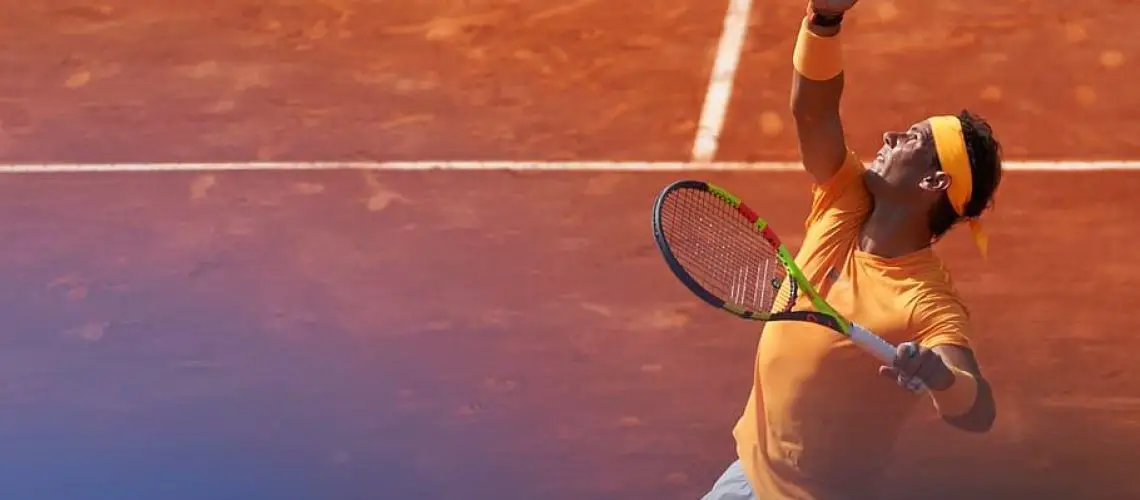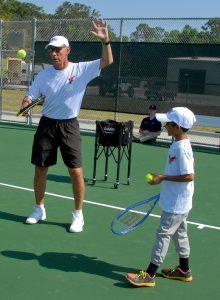We may earn money or products from the companies mentioned in this post.
Introduction

When it comes to playing tennis, warming up is often overlooked or rushed through However, taking the time to properly warm up before a match or practice session can have significant benefits for both your performance and overall well-being In this article, we will explore the importance of warming up for tennis and address some common misconceptions that surround this essential part of any tennis player’s routine
Importance of Warming Up for Tennis
Warming up is not just a mundane task to check off your list before hitting the court; it plays a crucial role in preparing your body and mind for the physical demands of tennis
1 Injury Prevention
Injuries are an unfortunate reality in any sport, including tennis However, by incorporating a proper warm-up routine into your pre-match ritual, you can significantly reduce the risk of sustaining injuries such as strains, sprains, and muscle pulls
A thorough warm-up increases blood flow to your muscles, making them more pliable and less prone to tears or strains during intense movements on the court It also helps lubricate your joints and improves their range of motion, reducing the chances of joint-related injuries
2 Improved Performance
Warming up not only helps prevent injuries but also enhances your on-court performance By gradually increasing your heart rate and body temperature through dynamic exercises like jogging or skipping rope, you prepare your cardiovascular system for the upcoming physical exertion
This increased blood flow carries oxygen and nutrients more efficiently to your muscles, allowing them to work optimally during intense rallies and quick directional changes Additionally, a thorough warm-up primes your nervous system by improving coordination and reaction times—essential elements for executing precise shots under pressure
Common Misconceptions about Warming Up
Despite the proven benefits of warming up, there are still some misconceptions that persist among tennis players
1 Warming Up Takes Too Much Time
One common misconception is that warming up is a time-consuming process that eats into valuable practice or match time However, an effective warm-up routine can be completed in as little as 10 to 15 minutes
By focusing on dynamic stretches and exercises that mimic the movements you will perform during play, you can efficiently prepare your body without sacrificing significant amounts of time Remember, investing a few minutes in warming up can save hours sidelined with potential injuries
2 Warming Up Is Only for Professionals
Some amateur players believe that warming up is only necessary for professional athletes who engage in high-intensity training regularly However, this couldn’t be further from the truth
No matter your skill level or frequency of play, warming up is essential for everyone Whether you’re playing a casual match with friends or competing in a tournament, taking the time to properly warm up ensures that your body and mind are ready to perform at their best
3 Static Stretching Is Sufficient
While static stretching has its place in improving flexibility and preventing muscle imbalances, it should not be the sole focus of your warm-up routine
Incorporating dynamic stretches and movements that mimic the specific demands of tennis helps activate and engage multiple muscle groups simultaneously This prepares your body for the explosive bursts of energy required during intense rallies or quick sprints across the court

Dynamic Stretching and Exercises

The Benefits of Dynamic Stretching vs Static Stretching
When it comes to preparing your body for a game of tennis, dynamic stretching takes the spotlight Unlike static stretching, which involves holding a stretch for an extended period, dynamic stretching involves active movements that mimic the actions you’ll perform during play This approach offers several advantages:
-
Increased blood flow to muscles:
Dynamic stretching gets your heart pumping and increases blood circulation to your muscles This boost in blood flow delivers oxygen and nutrients, helping to prepare your muscles for optimal performance -
Activation of muscle groups used in tennis:
By engaging specific muscle groups through dynamic stretches, you activate and warm up those areas directly involved in playing tennis This targeted activation primes your body for the demands of the sport -
Enhanced range of motion and flexibility:
Dynamic stretches promote improved flexibility by gradually increasing your joint’s range of motion This increased flexibility allows you to move more freely on the court, reducing the risk of injury and enhancing overall performance
Examples of Dynamic Exercises for Tennis Players
To incorporate dynamic stretching into your pre-match routine, here are some effective exercises designed specifically for tennis players:
-
Leg swings (front-to-back and side-to-side):
Swing each leg forward and backward in a controlled manner while maintaining balance Then repeat the movement from side to side These leg swings loosen up your hips, hamstrings, quadriceps, and glutes -
Arm circles (forward and backward):
Stand with feet shoulder-width apart and extend both arms straight out to the sides Begin making small circles with your arms, gradually increasing their size After a few rotations, switch directions This exercise warms up the shoulders, chest, and back -
High knees and butt kicks:
Alternate between running in place while lifting your knees as high as possible and jogging while kicking your heels towards your glutes These movements activate the lower body muscles, including the quadriceps, hamstrings, and calves -
Walking lunges with torso twist:
Take a step forward into a lunge position while simultaneously rotating your torso towards the side of the front leg Push off with your front leg to return to an upright position and repeat on the other side This exercise engages multiple muscle groups throughout your legs, core, and obliques
Types of Movement Patterns to Focus on During Warm-up Exercises
A comprehensive warm-up routine for tennis should incorporate various movement patterns that mimic those used during gameplay Here are three important types of movement patterns to include in your warm-up:
-
Lateral movements:
Side-to-side shuffles or lateral lunges help prepare you for quick lateral movements on the court These movements engage the inner and outer thighs, glutes, and hip abductor muscles -
Linear movements:
Incorporate forward sprints or skipping exercises to activate muscles used for linear acceleration and deceleration This includes engaging your quadriceps, hamstrings, calves, and hip flexors -
Explosive movements:
Include exercises that involve explosive power such as jumping jacks or squat jumps These movements enhance lower body strength and power necessary for explosive shots like serves or overhead smashes
By incorporating dynamic stretching and exercises into your warm-up routine, you’ll prepare your body for the specific demands of tennis Remember, a well-prepared body is less prone to injuries and more capable of delivering peak performance on the court
The importance of incorporating sport-specific drills into the warm-up routine

When it comes to tennis, warming up is not just about getting your heart rate up and loosening your muscles It’s also an opportunity to refine your technique, improve your footwork, and enhance your hand-eye coordination By incorporating sport-specific drills into your warm-up routine, you can give yourself a competitive edge on the court
1 Improving technique and footwork
Tennis requires precise technique and agile footwork During the warm-up, you can focus on specific drills that target these areas For example, practicing shadow swings or hitting against a wall can help you fine-tune your strokes and develop muscle memory Incorporating ladder drills or agility exercises can also improve your footwork and quickness on the court
2 Increasing hand-eye coordination
In tennis, having excellent hand-eye coordination is crucial for successfully returning shots and placing them accurately By including drills that challenge your hand-eye coordination in your warm-up routine, such as playing catch with a tennis ball or using reaction balls, you can sharpen this essential skill
3 Practicing different types of shots
Tennis encompasses various types of shots: forehands, backhands, volleys, serves, and more Incorporating specific drills for each type of shot during the warm-up allows you to practice and refine these skills before stepping onto the court for a match or practice session
Examples of tennis-specific warm-up activities

1 Mini-tennis rallies with a partner
A fun way to warm up while honing your technique is by engaging in mini-tennis rallies with a partner This activity involves hitting softer shots over a shorter distance, allowing you to focus on control, placement, and consistency It’s a great warm-up exercise that also simulates real match situations
2 Volleys at the net
If you want to improve your net game and volleying skills, incorporating volleys at the net into your warm-up routine is essential This activity involves standing near the net while your partner hits balls for you to volley back It helps improve hand-eye coordination, reflexes, and accuracy in close-range shots
3 Groundstroke crosscourt rallies
To get your groundstrokes dialed in during the warm-up, engaging in crosscourt rallies is an effective drill This activity involves rallying with your partner from one side of the court to the other, hitting shots diagonally across the net It allows you to practice consistent strokes while improving shot placement and control
4 Serving practice
The serve is arguably one of the most important shots in tennis Devoting time to serving practice during your warm-up routine can significantly impact your performance on the court You can incorporate various serving drills such as targeting specific areas of the service box or practicing different types of serves like slice or kick serves
Cool Down and Recovery

After an intense game of tennis, taking the time to cool down properly is crucial for your body’s recovery It’s like giving yourself a gentle pat on the back, allowing your heart rate to return to its normal levels and preventing any potential stiffness or soreness from creeping in
Why cooling down is important after playing tennis
A proper cool-down routine helps bring your heart rate back down to baseline When you’re engaged in a high-intensity activity like tennis, your heart pumps faster to supply oxygen-rich blood to your muscles Cooling down gradually allows your cardiovascular system to adjust and return to its regular pace, reducing the risk of dizziness or lightheadedness
Additionally, cooling down can help prevent stiffness and soreness by aiding in the removal of lactic acid build-up in your muscles Lactic acid accumulates during intense exercise, causing that familiar burning sensation By engaging in light movement post-match, you encourage blood flow and help flush out toxins, promoting faster muscle recovery
Examples of cool-down activities
Now that you understand the importance of cooling down after a game of tennis let’s explore some effective cool-down activities:
-
Static stretching:
Target different muscle groups with static stretches that gently elongate the muscles This helps improve flexibility and prevent post-exercise muscle tightness -
Foam rolling or self-massage:
Use a foam roller or massage tools on areas that feel particularly tight or knotted Applying gentle pressure can release tension and improve circulation -
Breathing exercises or meditation:
Take a few moments to focus on deep breathing techniques or engage in mindfulness meditation This can help calm your mind, reduce stress, and promote relaxation
Remember, the cool-down phase is just as important as the warm-up and main activity By incorporating these cool-down activities into your post-tennis routine, you’ll enhance your recovery process and set yourself up for future success on the court
Useful Links

Tennis Warm Up Drills on Mini Court
Tennis Warm Up Games
Best Warm-Up Exercises Before Playing Tennis
How To Warm Up For A Tennis Match
Tennis warm up drills: Prepare your body with these simple …
Acute effects of dynamic versus foam rolling warm-up …
Do The Tennis 10+ Warmup/Cool Down
How I warm up before a tennis match
Tennis Warm Up Drills for High Performance Tennis Players
Dynamic Warm Up
How do tennis players warm up before matches?
Warm-up exercises for tennis elbow – My Health Alberta
Warm up exercises to get you tennis court ready
The Standardized Warm-Up for Platform Tennis
Warm up and cool down like a tennis pro
Warm-Up And Stretching For Tennis Players
The 7 best warm-ups for tennis and pickleball
Warm-up for Tennis
Warm Up Drills for Tennis – Facebook






